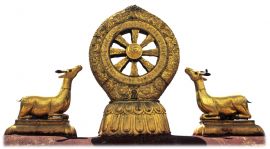Tibetan Buddhism
Buddhism is a method for coming to know our deep, inner nature, which is wisdom. With this kind of wisdom, we can achieve unchangeable happiness. This means that we can use wisdom to liberate from suffering, since changeable happiness is the root of suffering.
In this world, nothing continues. Everything ends; everything changes. From the perspective of our conceptual mind, everything is always ceasing and arising. This kind of existence is not safe, not absolute. We need to understand the nature of truth to understand this existence. Therefore, it is fundamental to the Buddhist approach to understand that there are two levels of truth: conventional truth and absolute truth.
When we practice Buddhism, we practice wisdom and method. The method is compassion. This is the path of Buddhism. Compassion is not emotion; it is logic. We are the ones that benefit from cultivating compassion. Compassion and love open us and lead us to greater understanding, realizations and wisdom. Love is the universal wisdom.
Finally, the achievement of Buddhism is a perfect body and perfect mind—perfect existence. It is ignorance that keeps us from a perfect existence. We are ignorant of our true nature and the true nature of all phenomena. We are ignorant of emptiness and our infinite potential. We are ignorant of the fact that nothing stays the same, that one day we will lose everything, even our happiness. And so, we become attached to our happiness. And when the day comes that we lose our happiness, we become angry. Why do we become angry? Because of the pain of losing. And then, because of anger we are ignorant. And the cycle repeats. This is the endless cycle of samsara—repeat, repeat, repeat. Ignorance causes attachment, attachment causes anger, anger causes ignorance. Then there is pain and suffering. Only love and compassion can give us the wisdom to see, to wake up.
Love is the golden key that liberates us. Love is freedom. With love, change is never a problem. With love, change is only possibility and potential.
Buddhism includes 84,000 different methods. There is a method for everyone, no matter where you are now or your kind of psychology. These methods fall into three baskets: discipline, mindfulness and alertness mind. Discipline means vow. It means renouncing that which does not help us. Mindfulness means meditation. It means developing focus, awareness and calmness. Alertness mind means wisdom. It means leaving everything how it is with no judgment, just stillness and pure, direct perception. All methods lead us to a deeper understanding of our own nature.
One can practice Buddhism in any moment because there are many ways to practice. You can practice through meditation, like Tummo or mindfulness meditation. If you don’t want to meditate, then practice with bliss or union practice with yab yum. If you like movement, practice with Tsa Lung. If you like sleeping, then practice with sleep yoga and dream yoga. And if you don’t like to practice, then you can use the moment of death.
It is like we are sick and Buddhism makes us healthy. Buddha, the teacher, is the doctor that guides us. Dharma, the Buddhist teachings, is the medicine that heals us. And the Sangha, the community of fellow practitioners, is the nurse that helps us. But we are the patient and we have to take responsibility for our own wellness. We may be told what to do, but we must do it. It is up to us whether or not we use the medicine.
Being healthy and happy yourself is the best way to help others. May all beings be happy.

